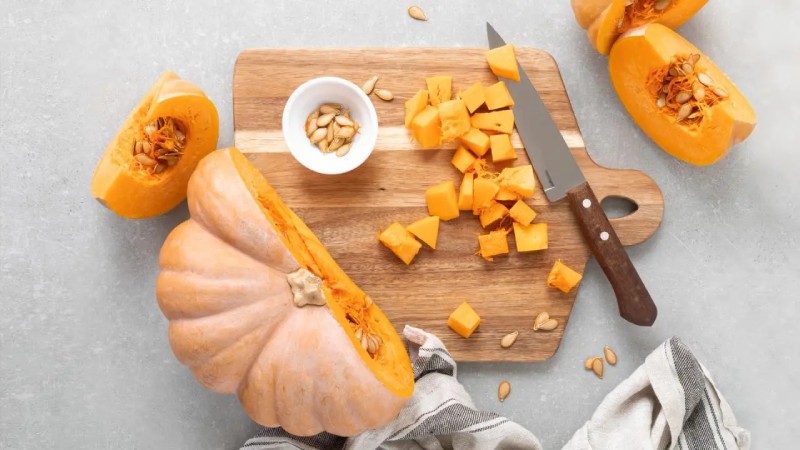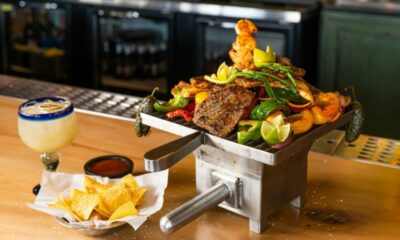Food
65 Interesting and Amazing Facts about Pumpkins You Should Need to Know

Pumpkins are fruits of some varieties of squash in the gourd family (Cucurbitaceae), such as Cucurbita pepo, C. moschata, and C. maxima. They are typically distinguished by a hard orange rind with distinctive grooves. Pumpkins are frequently cultivated for human consumption, decoration purposes, and also for livestock feed.
Though pumpkin spice lattes have been the talk of the fall season for the past five centuries, pumpkins themselves have been around for much longer. It’s true that the fruit adds flavor to our favorite Starbucks drink, Thanksgiving desserts, and the most haunted holiday of the year, but there’s so much more to this fruit than meets the eye. Think about all the applications this superfood can have and the history of fall’s most well-known flavor as you carve a few pumpkins in preparation for Halloween. The most interesting pumpkin-related facts we could find are listed below:
65 Interesting and Amazing Facts about Pumpkin
- They were originally known as “gros melons,” which is equivalent to “pompions” in English, by a French explorer in 1584. The term “pumpkin” was not coined until the 17th century.
- Pumpkins are planted singly, in pairs, or in threes on small hills spaced approximately 2.5 to 3 meters (8 to 10 feet) apart. Pumpkins produce very long annual vines. From a botanical perspective, pumpkin fruits are a kind of berry called a pepo.
- Generally speaking, they weigh 4–8 kg (9–18 pounds) or more, though certain varieties are considerably smaller.
- The largest pumpkins are C. maxima varieties, which can weigh up to 34 kg (75 pounds); the heaviest pumpkins ever grown weighed over 907 kg (2,000 pounds).
- Pumpkins can be oblate, globular, or oblong in shape, and some have a white rind. They are typically yellowish to orange in color. The rind is smooth with typically faint ribs or furrows.
- The fruit stem is angled, ridged, and hard and woody. The fruits can be kept for a few months in a dry place that is well above freezing temperatures once they reach maturity in early autumn.
- Pumpkin is primarily served as a vegetable in Europe and South America, where it can be substituted for other winter squashes.
- Pumpkin pie is a traditional Thanksgiving and Christmas dessert in the US and Canada.
- Large beets were lit with embers in England to ward off evil spirits. Though they discovered that carving pumpkins was considerably simpler, Irish immigrants carried their traditions to America.
- This makes a good deal of sense given that, well, Antarctica is an icy tundra all the time.
- C. moschata is the most common variety used to make canned pumpkins, though it can also be combined with other winter squashes like butternut squash (C. moschata).
- Pumpkins are a popular autumn decoration, especially the common field pumpkin, C. pepo.
- Pumpkins are sometimes used as jack-o’-lanterns for Halloween, in which the inside is hollowed out and a light is inserted to shine through a face carved into the fruit’s wall.
- Pumpkins need to be planted in late May or early July, depending on the region, in order for them to be ready for Halloween.
- All species of pumpkins have edible seeds, which are often roasted. They go by the name “pepitas” in the US.
- Some C. argyrosperma species are also referred to as pumpkins.
- Illinois harvests pumpkins and the state calls itself the “Pumpkin Capital of the World.” However, Illinois is not the only state that enjoys pumpkins. In addition, California, Pennsylvania, Ohio, and Indiana produce a lot of pumpkins.
- 95% of pumpkins grown in the United States are harvested on Illinois soil, according to the University of Illinois. Morton is said to be in charge of producing 80% of the canned pumpkin production in the world.
- Over 800 million of the 1.5 billion pounds of pumpkins are ready to be picked in a single month of the year.
- Pumpkins belong to the same family as gourds as cucumbers, melons, cantaloupe, and zucchini.
- Any form of pumpkin, even those in cans, is incredibly nutrient-dense. However, eating pumpkin seeds as a snack is perfect.
- Antioxidants abound in pumpkins, including beta-carotene, which your body uses to convert to vitamin A and aids in the prevention of infections, vision issues, and skin protection.
- While there is some pumpkin puree in a pumpkin spice latte, the main flavor comes from the pumpkin spice blend, which also contains cloves, nutmeg, and cinnamon to enhance the flavor.
- Long before the Pilgrims arrived, Native Americans were cultivating pumpkins, and they even gave the Pilgrims advice on how to harvest and cook them.
- It is said that pumpkin custard was served at the first Thanksgiving feast in 1621, which was attended by both Native Americans and Pilgrims.
- The fruit used to be thought of as a treatment for snakebites and freckle removal.
- It takes 90 to 120 days for pumpkins to reach October, so farmers have to start growing them in the spring.
- Planting them between May and July is advised because they take 90 to 120 days to grow. They are high in iron and can be eaten roasted. Edible flowers can also be found on pumpkin vines.
- Pollution is necessary for pumpkin growth in the fall. Squash bees, wild bees, bumble bees, and honey bees all aid in pollinating pumpkin flowers.
- This food is excellent for your cats and dogs. In addition to their many health advantages, pumpkins can aid in digestion and remove excess water. This is another instance where you should consult your veterinarian before giving it to Fido.
- It seems that the Irish carved faces on turnips and potatoes to ward off evil spirits. Compared to carving faces into pumpkins, they found it easier.
- Pumpkins would frequently be chopped, stripped, and woven into mats. Additionally, the seeds were used to treat a variety of illnesses, including digestive problems.
- Teams engaged in a pumpkin-launching competition in which air cannons shot pumpkins nearly five thousand feet into the air. Following a tragic accident in 2016, the event was postponed until 2017.
- Ever wonder why orange is the color of pumpkins? The reason for this is that they contain beta-carotene. Additionally, they are available in a variety of colors, such as red, yellow, and green.
- Did you ever try a beer made with pumpkins? This fall drink is perfect if you’re trying to kick a sweet tooth because it’s loaded with sugar and pumpkin spice.
- They were known as “gros melons” or, more accurately, large melons before we started calling them pumpkins.
- According to the Guinness World Records, New Bremen Giant Pumpkin Growers won a baking competition in Ohio and created a pumpkin pie that weighed 3,699 lbs.
- In addition to other things, the Spanish explorer is said to have brought potatoes and corn back with him.
- In the Korean dish ssam, leafy vegetables are wrapped around a piece of meat. In addition to other foods, you can use lettuce, cabbage, and pumpkin leaves.
- The word “pumpkin” originates from the German word “pepon,” which translates to “large melon.”
- Though they resemble vegetables, pumpkins are actually fruits! Pumpkins are produced from the flowers of their respective plants, just like cucumbers, tomatoes, and avocados. They are all fruits as a result.
- Another variety of winter squash is the pumpkin. Yes, technically speaking, all squashes are also fruits. A pumpkin has approximately 500 seeds in it.
- With imaginative names like Baby Bear, Spooktacular, Ghost Rider, Tricky Jack, and Sweetie Pie, there are over 45 distinct varieties of pumpkin.
- The largest species of pumpkin overall is the Atlantic Giant. They have a 50-pound growth rate per day!
- Pumpkins may be eaten in all parts, including the skin, stem, leaves, and flowers. Squash blossoms, including pumpkin blossoms, are edible raw. They taste especially good when fried in a light batter!
- According to 36% of Americans, pumpkin pie is the best Thanksgiving dessert over other classic choices like pecan, apple, or sweet potato.
- Though not particularly tasty, those enormous pumpkins can be eaten. For pies and soups, use small sugar pumpkins only.
- Though not in the form we know it today, pumpkin pie recipes first appeared in the colonies. Pumpkins were hollowed out, their seeds removed, and their interiors filled with milk, spices, and honey before being baked in hot ashes by the colonists.
- Like carrots and sweet potatoes, pumpkin gets its orange color from beta-carotene, which is abundant in pumpkin. After consumption, beta carotene transforms into vitamin A, which is excellent for the health of your skin, eyes, and immune system.
- Pumpkin seed roasts are delicious and nourishing! They are rich in iron and protein and low in calories.
- Canned pumpkin in a can consists of less than 100 calories and half a gram of fat per cup. By contrast, three times as many calories are found in the same serving size of sweet potatoes. They also contain more potassium than bananas, more fiber than kale, and a wealth of heart-healthy minerals like iron and magnesium.
- Mexico and Central America are the native home of the pumpkin. They were first small and bitter, but Central and Native Americans selectively bred them to be bigger, fleshier, and sweeter.
- The Pilgrims were unfamiliar with cooking this gourd when they came to North America. Thus, they learned from the Native Americans how to grow and prepare fresh pumpkins.
- Pumpkin was probably served at the first Thanksgiving since it was a staple crop. However, their take on pumpkin pie differed greatly from ours. They hollowed out a pumpkin, filled it with a mixture of milk, honey, and spices, and baked it in the fire’s ash without using butter or flour for the crust.
- Many Americans planted “Victory Gardens” in order to augment their rations of groceries during World War II. In 1944, Pennsylvania’s The Victory Garden Handbook advised cultivating and consuming pumpkins due to their high nutritional content.
- The original Jack-o-Lanterns weren’t even made of pumpkins. Turnips were used to make them! According to a folktale, “Stingy Jack” attempted to con the devil into covering his bar tab. The devil prevented Jack from entering the afterlife after his death. Rather, he was forced to travel the planet at night with only one coal for light. He became known as “Jack of the Lantern” after placing his coal inside a turnip that had been hollowed out. Because of this Irish legend, turnip carvings in Jack’s image are customarily done to ward him off.
- The modern Jack o’ Lantern originated when Irish immigrants discovered that pumpkins were far more suited for carving than turnips when they immigrated to America.
- Pumpkins are native to Central America, but they can now be found growing on every continent save Antarctica.
- Illinois emerges victorious in the competition for pumpkin production, cultivating more than 12,000 acres of pumpkins annually. More than double the number of any other state! (A significant producer of pumpkins in the area, family farms in Michigan supply us with a large number of our pumpkins.)
- Known as the “Pumpkin Capital of the World,” Morton, Illinois Libby’s, which produces 85% of the canned pumpkin worldwide, is based in Morton!
- In the US, more than 1.5 billion pounds of pumpkins are grown annually.
- 2,624 lbs is the current record for the heaviest pumpkin in the world. That is the weight of a Ford Maverick from 1971! Mathias Willemijns, a Belgian, grew this enormous gourd in 2016. 2,528 lbs was the heaviest pumpkin ever grown in the United States. In 2018, Steve Geddes of New Hampshire grew it.
- The New Bremen Pumpkinfest in Ohio produced the biggest pumpkin pie ever. This pie, which held the Guinness World Record, weighed 3,699 pounds and measured 20 feet in diameter. There were 440 sheets of dough used to make its crust!
- The Guinness World Record for the most pumpkins carved in an hour is currently held by Trevor Hunt. In sixty minutes, he carved 109 pumpkins, taking only 33 seconds to carve each one.
- Every year on October 26, National Pumpkin Day is observed to honor one of the most popular and versatile gourds in the world.
-

 Business4 weeks ago
Business4 weeks agoNayef Doleh Examines International Humanitarian Fundraising Strategies
-

 Business3 weeks ago
Business3 weeks agoHow to fill MSME Form 1? Step-by-Step Guide
-

 Business4 weeks ago
Business4 weeks agoHow Black Banx is Redefining Global Banking Strategies in 2025
-

 Festivals & Events4 weeks ago
Festivals & Events4 weeks agoInteresting Facts about St. Patrick’s Day
-
Business3 weeks ago
From Marine to Chief: The Leadership Journey of Sean Mannix
-

 Food4 weeks ago
Food4 weeks agoGeorgiy Balyuk Highlights Savannah’s Charm and Houston’s Best Eats
-

 Festivals & Events3 weeks ago
Festivals & Events3 weeks agoGoogle Celebrates Cherry Blossom Season with Animated Doodle
-

 Gadget3 weeks ago
Gadget3 weeks agoAfter Grand Success on BLDC Ceiling Fan, Eff4 Is Launching Smart Bulb

























